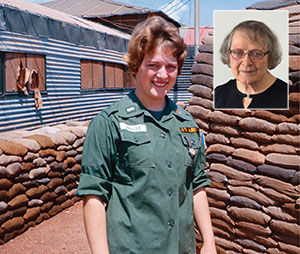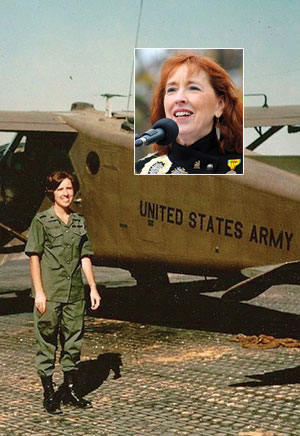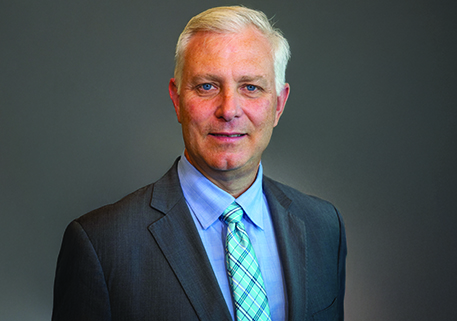 Sitting on a pile of sandbags, a bronze-sculpted nurse supports an injured soldier sprawled across her lap. His arms and legs seem nearly lifeless. Next to them, another nurse stands, scanning the skies for any sign of a medevac helicopter. A third kneels and slumps slightly forward with an empty helmet resting on her knee.
Sitting on a pile of sandbags, a bronze-sculpted nurse supports an injured soldier sprawled across her lap. His arms and legs seem nearly lifeless. Next to them, another nurse stands, scanning the skies for any sign of a medevac helicopter. A third kneels and slumps slightly forward with an empty helmet resting on her knee.
For many, the Vietnam Women’s Memorial on the National Mall in Washington, D.C., is their first introduction to the service and sacrifice of a historically forgotten and unrecognized group of heroes.
During the Vietnam War, nightly news was dominated by images of fatigued warfighting men navigating Vietnam’s jungles. A female nurse deftly working to save lives inside a makeshift hospital in the middle of a war zone was not the image broadcast into Americans’ living rooms.
Yet more than 265,000 women served across the globe during the Vietnam War, either in uniform or as civilian personnel. An estimated 10,000 of them served in Vietnam, mostly as nurses. They saved countless lives, consoled gravely injured teenage soldiers and held the hands of men as they took their last breaths.
Those same women returned to a country that for years remained largely unaware of their service and sacrifice. They struggled in silence, even as they dedicated their lives to helping others process the horrors of war. When the country began to properly honor its Vietnam veterans, it was women who made sure we remembered all who were there.

And their work isn’t finished.
During an honor flight in April 2024, Donna Korf, who served in Vietnam as an Army nurse, met a Vietnam Navy veteran.
“He said to me, ‘I didn’t know there were women in Vietnam!’” Korf recalled.
At one point, a general shook the hands of the veterans on the flight.
“I was right there,” Korf said. “Never shook my hand.”
‘SEND ME TO VIETNAM’
Korf was a nursing school student when she saw a picture of an Army nurse in a magazine. The ad read “Join the Army; see the world.” This was before the U.S. deployed combat troops to Vietnam, so for 21-year-old Korf, the Army seemed like a safe and grand adventure.
The following year, she was on her way to Vietnam. When she arrived by ship, the men disembarked carrying rifles and wearing steel helmets. The women stepped off in baseball caps.
“Nobody told us to wear our metal hats,” Korf said.
Later, she’d use that hat to scoop water out of the makeshift hospital after heavy rains.

Receiving her commission in 1967 in the months leading up to the catastrophic Tet Offensive, Linda Schwartz knew she’d signed up for a war zone. She chose the Air Force after seeing a magazine ad calling for flight nurses. By 1968, she was at Tachikawa Air Base in Japan, where battle-wounded warfighters from Vietnam would stabilize before making the journey home.
On her first day in Japan, Schwartz helped treat a soldier whose midsection had been blown out by an accidental gunshot. When she turned the patient over to put something beneath his back, Schwartz felt something strange. It was the med tech’s hand coming through the other side of the massive wound.
By the end of the day, she wondered if she had made the biggest mistake of her life.
Like Schwartz, Diane Carlson Evans joined because of the ongoing war.
“I’ll join the Army Nurse Corps if you’ll send me to Vietnam,” she recalls telling the recruiter.
Evans’ brother was drafted in ’65, and she watched as her male neighbors were sent to war. As a nursing student doing clinical rotations before going to Vietnam, she cared for four generations of veterans. And at just 15 years old, Evans had assisted her mother at the local hospital.
So once Evans was in country, she said it was “exactly what I thought I was signing up for.”
‘THE NIGHT THAT CHANGED MY LIFE’
Korf quickly learned what she signed up for, too. When mortar sirens sounded, she took cover in bunkers made out of sandbags. When she learned that even Red Cross helicopters took fire, she knew no one was safe.
But like so many Vietnam nurses, what haunts Korf the most are the patients—the ones profoundly changed by war and the ones who didn’t survive.
Korf vividly recalls when nine of her 18 patients were on the brink of death. Korf’s personal mission was to make sure the Americans she treated didn’t die alone.
That night, she was diverted to tend to another patient. With no curtains blocking her view, she saw the moment a corpsman removed the expectant patient.
“And that’s the thing that bothers me, all these years,” Korf said, her voice wavering. “I never got back to him. … He didn’t have somebody there.”

Most, if not all, Vietnam nurses have stories like Korf’s. Evans filled a book with them.
She learned that sandbags weren’t the only protection from mortar attacks. When sirens sounded, nurses helped patients get under a bed. Those with tubes and ventilators got mattresses on top of them.
“We were the last to go under a bed for our protection,” Evans said. “This was women protecting men.”
Schwartz, the Air Force nurse, recalls the onslaught of casualties during the bloody Battle of Hamburger Hill in 1969. The mess hall at Tachikawa became a triage area.
She remembers two men, both badly wounded and unable to stand. The one who could talk begged nurses to take care of his friend who had a chest wound. It was the “take my buddy first” mentality of so many of the men who were wounded.
“That’s the night that changed my life forever,” Schwartz said.
Becoming a wartime nurse hadn’t been a mistake. It had been her calling.
HEALING WOUNDS
Like the men of Vietnam, women returned home to an America that denounced their service, often cruelly. And while the women were proud of their care for the war’s wounded, the country didn’t even recognize them as veterans, let alone understand their experiences.
Evans went back to a civilian nursing job where starting an IV unsupervised resulted in her being admonished for breaking the rules.
“I had started hundreds of IVs in Vietnam, and I started them in the dark, with a flashlight, when we were being rocketed,” Evans said.
She lasted three weeks before rejoining the Army Nurse Corps.
Schwartz served as a flight nurse across Europe until she had her first child in 1976 and went on reserve duty. Then in 1983, during a training exercise in a C-141, the hatch blew off the aircraft at 30,000 feet. The decompression injuries Schwartz sustained to her brain and spinal cord ended her military career.
Even while living with the traumas of service, these women—all of whom are proud DAV members—contributed incalculably to the veteran community.
Korf started a nursing career with the Department of Veterans Affairs health care system. She counseled Vietnam veterans on Agent Orange exposure and post-traumatic stress while ignoring her own struggles. Still, she found purpose and peace in helping veterans.
“They took care of me and I took care of them,” she said.
Evans led a 10-year crusade to get a memorial dedicated to all the women of the Vietnam War. She defied backlash and vitriol, rallied veterans from across the country and worked with organizations like DAV to get her fellow women veterans the recognition and honor they earned. The memorial was dedicated in 1993.
Last year, Korf read Evans’ book, “Healing Wounds.” After decades of pushing down her own trauma, something unlocked.
“Diane’s book is really probably what helped open up this box of tears that for years have been just bottled up,” she said.
After being medically discharged, Schwartz earned a master’s degree from the Yale School of Nursing. She eventually became involved in veterans advocacy, testifying in front of Congress about inadequate care for women veterans and holding leadership positions within Vietnam Veterans of America.
She fondly remembers working alongside Joy Ilem, now DAV’s national legislative director, in the early ’90s to secure the creation of the VA’s first Center for Women Veterans. She also served as Connecticut’s commissioner of veterans affairs and was later appointed by then-President Barack Obama as the VA’s assistant secretary for policy and planning.
Schwartz celebrates how far the VA and the country have come in recognizing women’s military service. She’s confident that women like Korf and Evans, and all those who came after, will protect that legacy and ensure women who served are never forgotten.
“The sisterhood is strong,” she said.
Learn how DAV advocates for women veterans of all generations at davwomenveterans.org.




